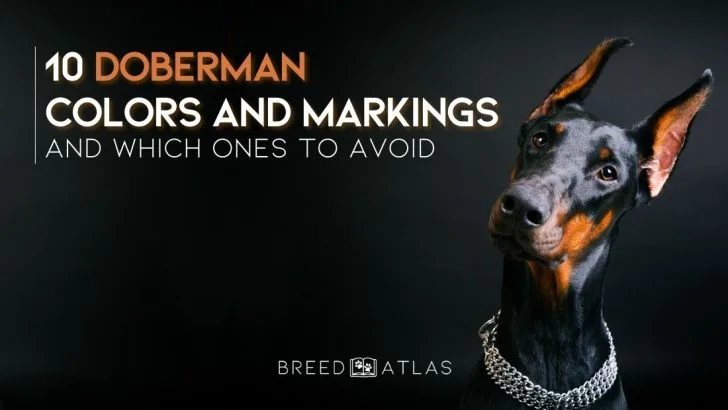Doberman is one of the most recognizable dog breeds out there. With their black coat with tan markings and a thin but strong body, this is a truly magnificent dog. But did you know there are more Doberman colors you can find? Ten, to be precise!
Just like human hair, a dog’s coat can also come in various colors due to genetics. While most breeds have what is known as standard or recognized colors, this doesn’t mean other options are not available.
Even our beloved Dobies can come in more than black and rust!
Let’s check out all of the Doberman colors and explore the genetics behind them!
Doberman Colors Overview
| Color | Recognized | Standard | Registration Code |
|---|---|---|---|
| Color | Recognized | Standard | Registration Code |
| Black and rust | YES | YES | 015 |
| Red and rust | YES | YES | 145 |
| Blue and rust | YES | YES | 042 |
| Fawn and rust | YES | YES | 316 |
| White | YES | NO | 199 |
| Black | NO | NO | N/A |
| Red | NO | NO | N/A |
| Blue | NO | NO | N/A |
| Fawn | NO | NO | N/A |
| Albino | NO | NO | N/A |
Standard Doberman Colors
While there are many colors of the Doberman, not all can be considered standard.
A standard color is not just recognized by the American Kennel Club (AKC) but also accepted as a part of the breed standard.
Only Doberman Pinschers in standard color can participate in dog shows. Also, most reputable breeders will only breed standard colors.
The reason behind this is more practical than you might know. Dogs in standard colors typically carry fewer faulty genes than those in non-standard colors.
This is because most of the dogs that come in ‘improper’ colors are a result of irresponsible breeding, sometimes even generations ago.
By sticking to standard colors, you can be more certain that you’re truly getting a purebred, healthy Doberman – although, of course, this isn’t the only thing you need to look for.
It’s important to note that different types of Dobermans might be registered in different kennel clubs, depending on where they’re from.
For example, European Dobermans typically follow the Federation Cynologique Internationale’s (FCI) standard, while AKC is responsible for the American Doberman type.
Due to easier understanding, we will speak about Doberman colors recognized by the AKC.
Black And Rust
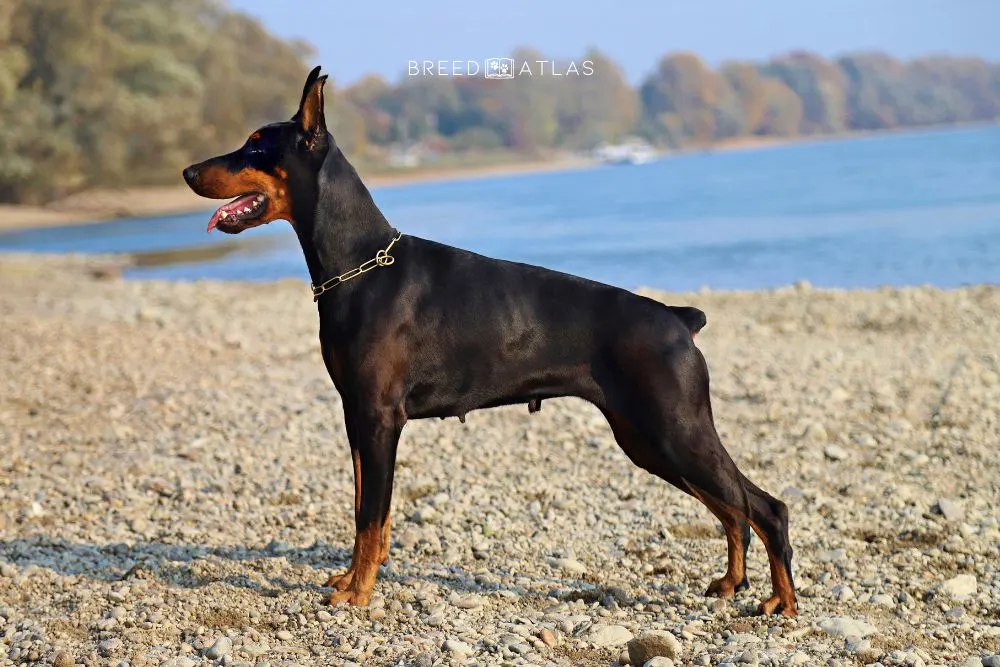
When you think of Doberman dogs, you think of a canine with a black coat and rust markings. This isn’t a surprise considering black and rust Dobermans are the most common of the different varieties of Dobermans.
These pups have a black coat with rust or tan markings on their muzzle, eyebrows, ears, chest, legs, and below the tail. Due to the shade of the marking, you might find them under the name “black and brown Doberman”, as well.
Just look at any mainstream media that showcases Doberman. Almost all (if not all!) of them will show this type of Dobie.
Most Doberman owners probably have this type of canine and might even find any other color variation weird.
Red And Rust
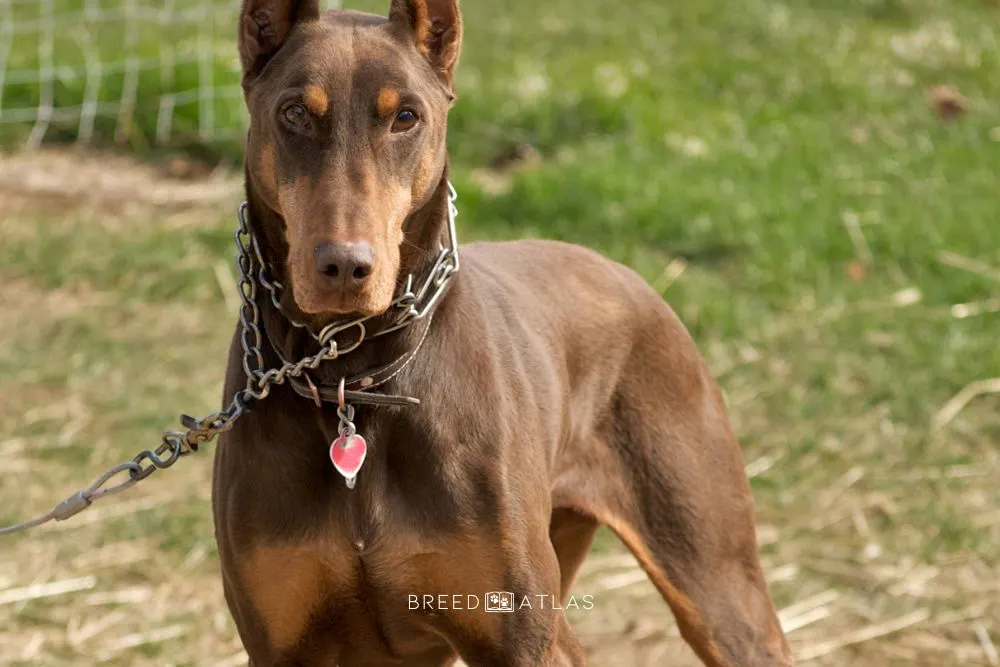
Next to black and rust, red and rust is the most popular color in the Doberman Pinscher breed.
Even though they are called “red,” many people consider them brown Dobermans, as they are a deep reddish-brown shade.
Just like black and rust Dobies, these red and rust doggies also have those classic Doberman markings. However, they are not as prominent, as red and tan shades are quite similar.
These pups give a nice twist to the standard Doberman look, and many dog lovers prefer them over their black counterparts.
Blue And Rust

Blue and rust Dobermans are some of the most beautiful dogs you can find, but are also very rare.
These are, in fact, Dobies with a blue dilution gene. This dilution gene turns the black color in the Doberman Pinscher into a gorgeous grayish-blue shade, giving him a rather unique appearance.
The blue hue can vary from light gray to a much darker charcoal. Some pups might even have a slight hint of purple!
Also, these pups might have blue eyes to match their beautiful coats.
Due to the shade of this diluted black, many will call these Dobies silver or slate color. However, they carry the genes for black and rust Doberman, but with a genetic mutation that is the cause of this specific color.
While these doggies keep the tan markings of a standard Doberman, the contrast between them and the base color will be much milder.
Still, it’s important to remember that the blue dilution gene is connected with certain health concerns, such as color dilution alopecia (CDA).
This doesn’t mean that all blue dogs will develop this specific type of alopecia; it just means that the chances of a blue dog having it are slightly increased.
Fawn And Rust

Fawn and rust is one of the least common color combinations in the Doberman breed.
Just like blue and rust Dobies, these pups are the result of dilution genes. However, this time, the gene affected red and rust dogs, giving them a unique white coffee shade.
These Doberman Pinschers are rather unique, as the tan markings usually appear darker than the rest of the coat. They might even look like you’ve put an inverted color filter on a standard Doberman!
You might be surprised to hear that the AKC accepts fawn and rust Dobermans. This is just proof of how a dog can be purebred even if they don’t really look the part.
Oh, and maybe you know these pups as Isabella Dobermans, as this is another name some people use.
Non-standard Doberman Colors
Non-standard Doberman colors are all colors and patterns these dogs can come in that are not accepted by AKC or other local kennel clubs.
Most of the time, when you see a dog that belongs to a certain breed but doesn’t have a color you’re used to seeing, he is in a so-called faulty color.
It’s important to note that AKC can recognize non-standard Doberman colors, but this doesn’t mean they are accepted as breed standard.
For example, the AKC can recognize a white Doberman Pinscher, but he won’t be able to participate in official dog and conformation shows.
As mentioned earlier, dogs in non-standard colors might be the result of inbreeding, and many kennel clubs won’t even allow you to register them as purebred.
Also, some non-standard colors, such as the infamous Merle pattern, can increase the chance of certain genetic conditions.
This is why most responsible breeders avoid purposely breeding these colors. Still, this doesn’t mean they are impossible to find.
White
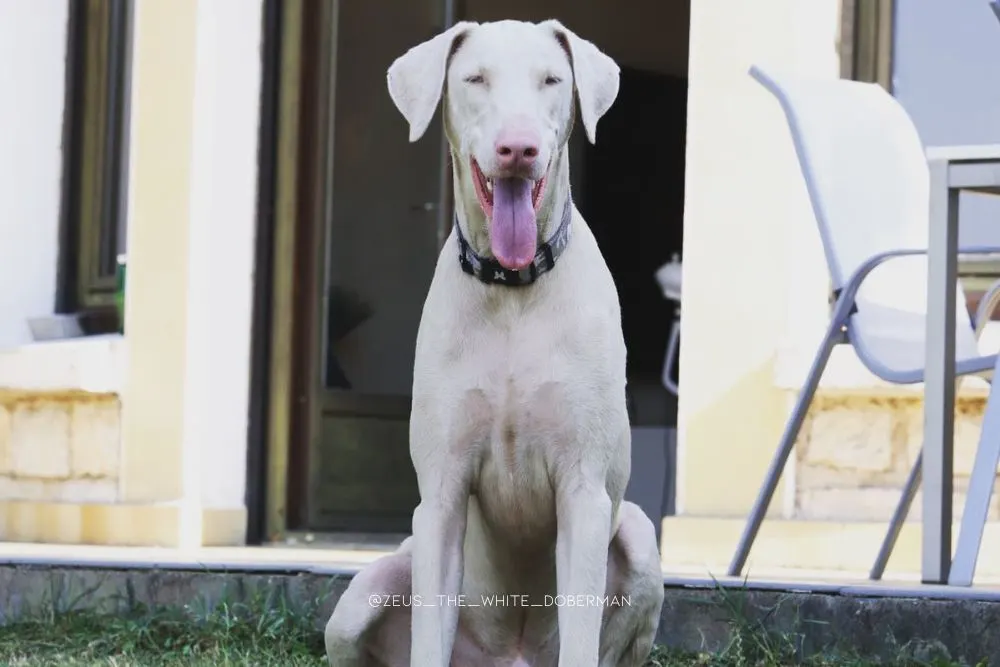
According to the AKC, white is one of the possible colors in Dobermans. Yes, this means this kennel club accepts white Dobermans – the only solid color on their list.
White Dobermans are rarely truly white. Most come in a light cream shade that might appear white at first glance, but if you compare them with albino Dobermans, you’ll easily spot the difference.
This is the youngest Doberman color that AKC recognized. According to the Doberman Pinscher Club of America (DPCA), the first recorded white Dobie in history, Sheba, was born in 1976.
However, it wasn’t until the early 1980s that this color was officially recognized. Soon, several white breeding stocks were created, and this color became more and more popular.
While you might be able to register a white Doberman with the AKC, these dogs cannot participate in conformation shows.
This is because white Dobies are a result of numerous in breedings, which is considered a bad breeding practice.
These pups have light blue eyes that give them a ghostly appearance.
Also, they are not considered albino, as they are not entirely stripped of all pigment, so don’t confuse the two. AKC doesn’t recognize albino Dobermans and considers them a result of a faulty genetic mutation that shouldn’t be spread.
Solid Black
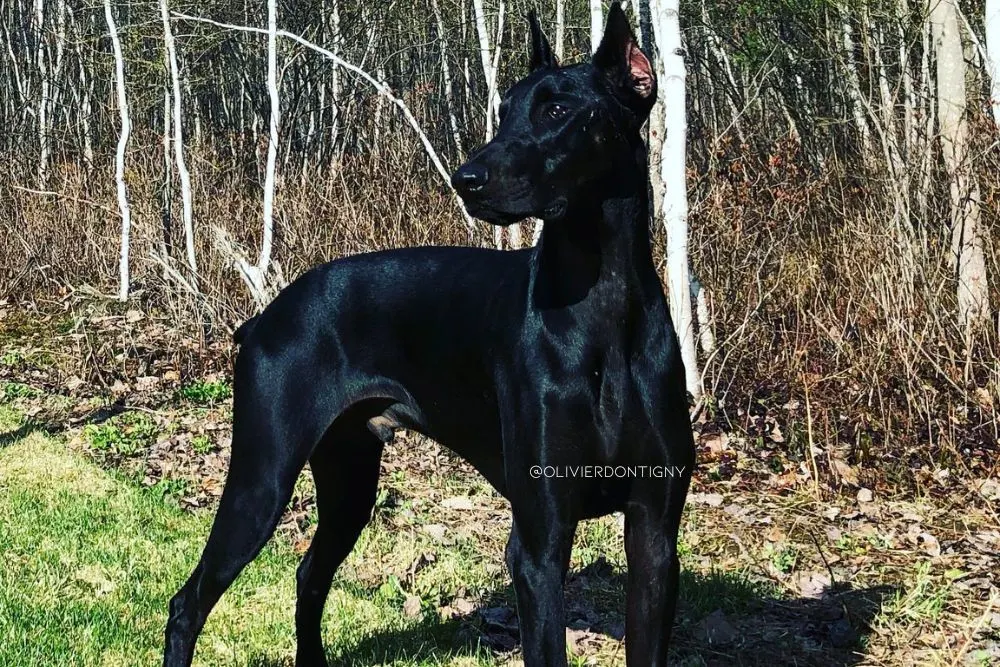
Did you know some Dobies can come in a solid color? While this color isn’t approved or even recognized by the AKC, these dogs indeed exist.
Solid black Dobermans, also known as melanistic black Dobermans, are rare dogs. You will hardly find any on the market or in the streets!
Since black and rust Dobies are considered standard, why are pure black Dobermans so rare? The main reason is that their intentional breeding is considered unethical due to some health problems that might arise.
Solid black Dobermans are a result of melanism, a health condition that leads to excessive melanin production. Melanistic animals can appear spontaneously in a litter, but they are extremely rare, and the chances of this happening are one in a thousand.
If you take a careful look, you’ll notice that these pups have rust markings, but they are very faint.
If there is an entire litter of black Dobermans, or if the dog appears to be entirely black, then there is likely some inbreeding or the dogs aren’t purebred at all.
As such, any responsible dog expert will advise you against purchasing a solid black Dobie. You can never know his full genetic background or health issues the pup might be prone to.
Solid Red
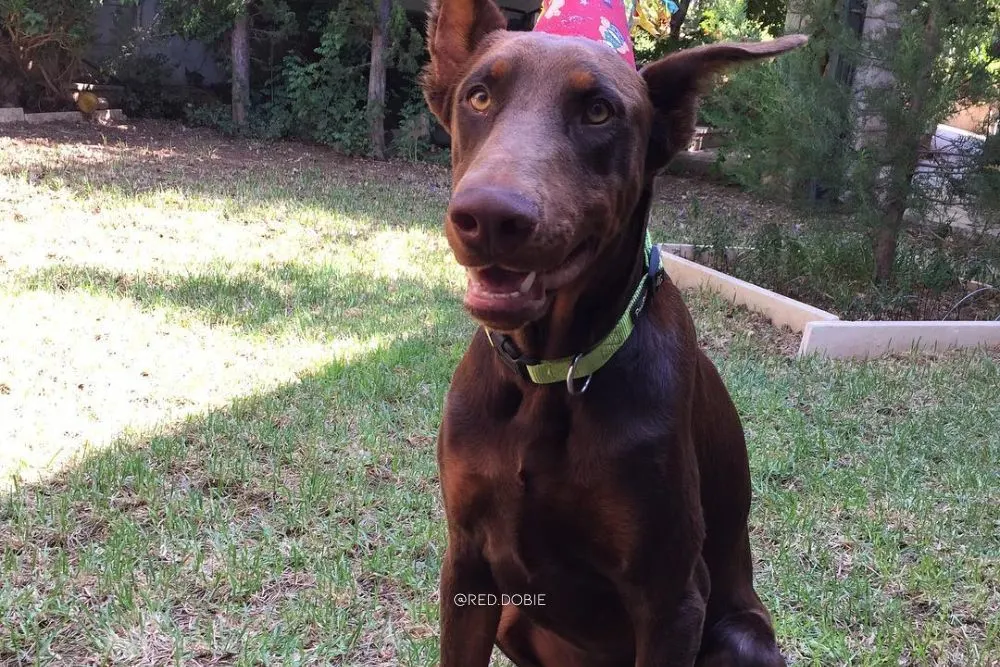
Also known as chocolate Dobermans, these are one of the rarer Doberman colors.
Solid red appears due to a unique genotype combination, and it is rare for two red and rust parents to produce a solid red puppy.
Because of this, many of these pups are considered a mixed breed, and solid red isn’t a color that AKC recognizes.
Just like other types of melanistic Dobermans, solid red Dobies are unethical to breed due to unknown genetics and potential health problems they might have.
Solid Blue
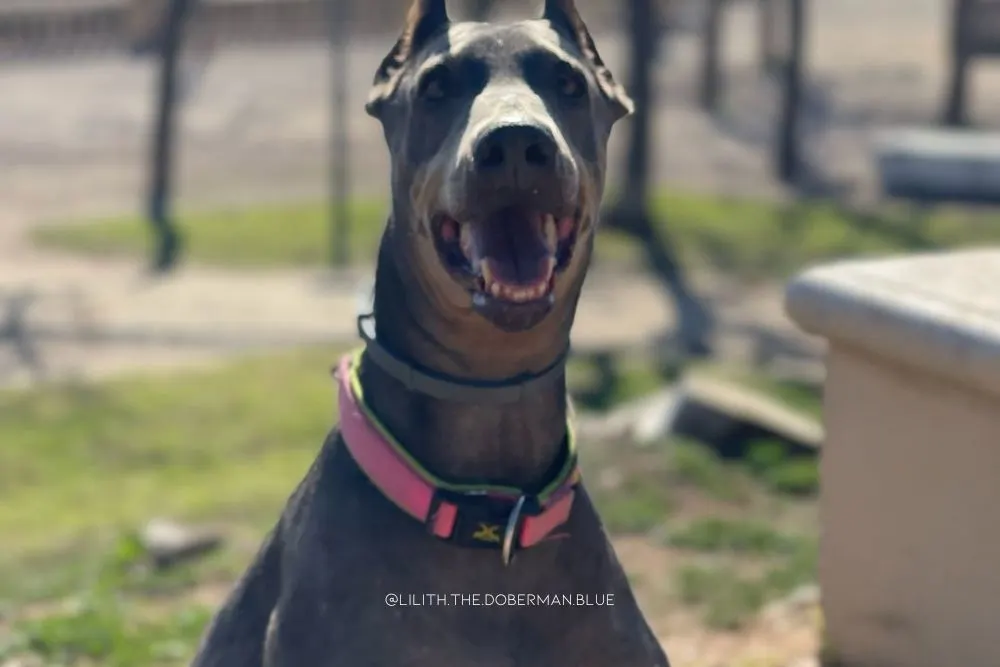
Just like in blue and rust Doberman, solid blue Dobies, in fact, carry black genes, but they are combined with a dilution gene that gives dogs that beautiful color.
This type of Doberman might be the rarest of them all – although all solid-colored Dobies are quite uncommon. A combination of melanistic dog and dilution genes is very infrequent, and you can consider yourself lucky if you’ve run across such a pup.
Just remember what I’ve said about blue color being connected with certain health conditions.
Also, most, if not all, of solid blue Dobermans are crossbreeds, and you can never know their full health background.
As such, I would never advise anyone to buy a solid blue Dobie, no matter how gorgeous they look.
Solid Fawn

You probably can see a common theme by now – The AKC does not accept solid colored Dobermans and they carry the risks of certain health problems. Melanistic fawn Dobermans are no different.
These dogs have that gorgeous white coffee shade, and the tan markings are barely visible or entirely invisible.
Diluted red Dobermans are extremely uncommon, and I have yet to see one in person.
While I can’t deny they truly look stunning, once again, I would ask you to avoid paying to support bad breeding practices.
Fawn Dobermans are often inbred or crossbred and likely come with numerous health concerns, such as an increased chance for dilated cardiomyopathy (DVM).
Albino
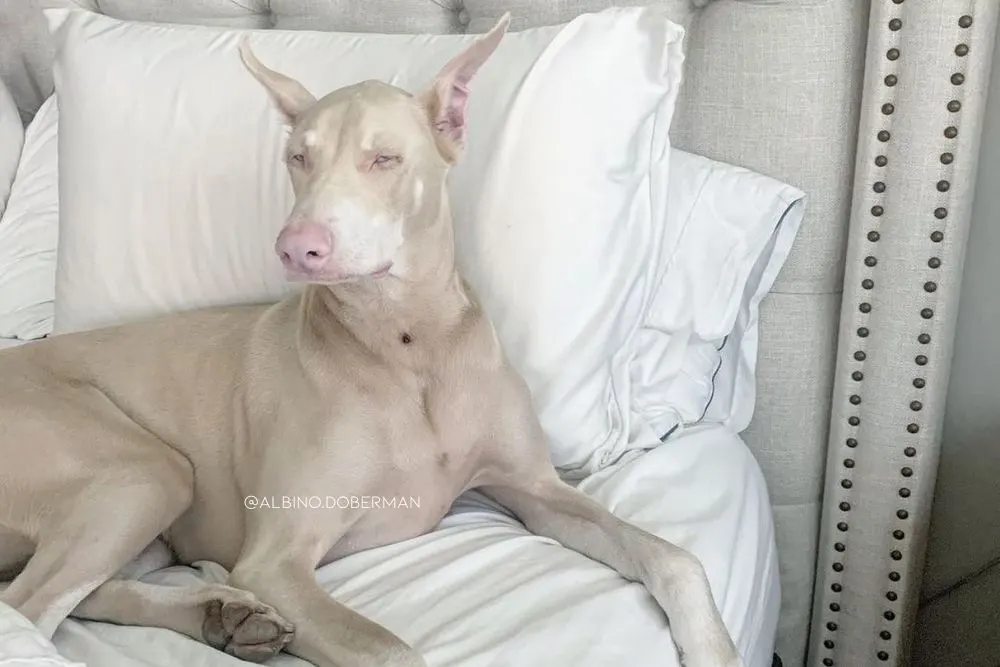
Finally, we have albino Dobermans.
Albino Dobies are very rare, as they are a result of a mutation that can remain hidden for generations.
In fact, it’s hard to even call albino white a color, as these pups suffer from albinism, a condition that causes a lack of pigmentation not just in a dog’s coat but also in its skin and eyes.
As a result, these dogs have pale pink noses and very pale, almost pink eyes.
Unfortunately, albino Dobermans are prone to numerous health conditions, such as sight and hearing problems, and an increased chance of skin issues and bone diseases, including hip dysplasia.
These dogs also have some different needs than their colorful counterparts. For example, they are extremely sensitive to sunburns, and their skin might peel after just a few hours in the fairly mild spring sun.
As such, these dogs are not intentionally bred. Actually, they are so rare that some might argue whether full albino Dobermans exist.
Doberman Markings
Dobermans have rather distinguished markings that don’t have many variations.
In fact, for the Dobie to be recognized by the AKC, he or she needs to have very specific markings that are a part of the breed standard.
As mentioned, a purebred Doberman will always have rust markings on his face – muzzle, to be more precise – eyebrows, ears, chest, and legs.
Some Dobies also have markings below their tails, but this is not mandatory.
Also, some AKC Dobermans might have a small white patch on their chest, and this is also perfectly fine. A white patch doesn’t mean your dog is faulty.
However, this is only according to the AKC, but what does FCI state?
European Doberman – or Dobermann – has clearly defined dark rust markings on the muzzle, cheeks, and above eyes. He also has markings on the throat, chest, the inside of his legs, on his feet, between the toes and ankles, and under the tail.
Also, white markings aren’t allowed.
Differences In Colors Between American and European Dobermans
There aren’t many differences between the two types of Dobermans. You have seen that even the markings are more or less the same, with the exception of the white chest spot.
However, as the two different kennel clubs register the two dogs, some different breeding practices have led to certain dissimilarities.
For example, the tan markings are typically a bit darker on European Dobermans.
Also, according to FCI, standard Doberman colors are:
- Black and rust
- Red and rust
Dilution genes are not allowed for European Dobermans, and FCI generally seems to be a bit more strict when determining what dogs you can register.
Does Color Really Matter?
After reading about all these colors in Doberman, you might think that this isn’t an important topic. In the end, a dog is a dog, and no matter its shade or pattern, he deserves love and attention.
However, the Doberman color might be more important than you think.
I have already briefly touched on why it is important whether a dog comes in a registered or non-registered color. It’s time to go into more detail.
If a dog is in a non-standard color, this usually means that its shade is due to some health concerns that have affected his appearance.
On the other hand, if the dog comes in a color that AKC doesn’t recognize, he is most likely a mutt.
Don’t get me wrong – there is nothing wrong with getting a mixed-breed dog. However, I have two issues with this:
- Why would you pay more money for a Doberman who isn’t even purebred?
- You risk getting a dog of an unknown background with an unknown health history and temperament.
Reputable breeders select their parent dogs after a carefully planned selection process. They make sure all of their puppies are healthy, have good genetics, and have an excellent temperament.
This also means staying away from bad coat color genetics.
As you can see, this isn’t about looks. Only colors that have been approved can come from healthy Dobermans.
Can Color Affect A Dog’s Temperament?
A dog’s coat color might affect a dog’s temperament, but not in the way you might think.
Your Doberman won’t be predisposed to behave in a certain way just because his coat is red or black.
However, if a dog comes in a non-standard color, chances are he comes from badly behaved parents. This means that he has a higher chance of having a bad temperament.
Not only that, but most backyard breeders who intentionally breed rare Doberman colors for profit don’t socialize their pups. As a result, the Doberman puppies they sell tend to be more prone to behavioral defects.
Doberman Pinschers are territorial dogs with a somewhat bad reputation. To make sure you have the best-behaved Dobie, it’s essential to purchase him from a good breeder.
This also means your dog is more likely to be in a standard black and rust or red or rust color.
Similarly, dogs who are in rare colors are likely to be more temperamental and unpredictable.
Health Problems Associated With Coat Color
It’s challenging to say that a certain coat color has caused a specific disease. However, some health problems are connected with coat color genes.
I have already stated some health issues caused by albinism. The same problems can occur with any coat color that leads to loss of pigment, whether total or partial.
For example, deafness is caused by a lack of pigment in a certain part of the ear, and any part of the skin without pigment will be more prone to sunburns.
With dilutes, the main issue is CDA.
While CDA isn’t that usual in most dilutes, it is particularly common in blue Dobermans. In fact, it is estimated that about 80% of blue and blue and rust Dobermans will develop CDA at a certain point during their lifetime.
A similar health condition, known as Black Hair Follicular Dysplasia, can occur in black Dobermans, but it isn’t too common.
Fortunately, most of these diseases can be prevented by careful breeding practices and expelling sick dogs from the gene pool.
What Is the Rarest Doberman Color?
With black and rust and red and rust Dobermans being so popular, it seems like any other color is the rarest one.
In general, solid-colored Dobermans are pretty rare. They are even rarer if there is a dilution gene present. This means that blue and fawn Dobermans are among the rarest ones.
White Dobermans are rare, but as there are a few breeders who intentionally produce them, I would guess they are a bit more common than fawn or blue ones.
Finally, albinism is so rare in Dobermans that some experts doubt they even exist. As such, it seems like albino Dobermans are indeed the rarest ones.
Having a rare dog is tempting. They tend to be costly, and some people even see them as prized pets.
However, there is usually a reason why a certain coat color is rare. Buying a dog just because he has a unique shade isn’t a good idea. You will likely end up spending lots of money on medical bills later on.
What Color Doberman Is The Most Expensive?
Doberman price depends on many things, not just coat color.
For example, show-quality dogs tend to cost more than working dogs.
Similarly, younger puppies will usually be costlier than adult dogs that you can no longer shape or even train properly.
If we talk about colors only, rare colors are always the more expensive ones. For example, while a standard, black and rust Doberman will typically cost between $400 and $2500, a rare, white Doberman can be sold for up to $5000.
Once again, I have to give you a disclaimer: While you shouldn’t pay thousands for a rare, sickly dog, you shouldn’t rush to pay the cheapest price for a pup, either.
Most of the time, cheap dogs are sold by puppy mills. Puppy mills don’t care about the dog’s well-being. Their only concern is to produce as many puppies as possible in the shortest amount of time.
These locations don’t conduct medical checks or socialization, which is how they can afford to sell their puppies at an affordable price.
Such dogs are often sick and come with behavioral problems, so it’s best to avoid them.
Bottom Line
As you can see, Dobermans are more colorful than one might think.
Most people imagine Doberman Pinschers as black and tan dogs with slim but strong bodies, cropped ears, and docked tails. This is how all the movies and shows represent Dobermans, after all.
Instead, there are 5 Doberman colors that AKC allows and 5 more that are unofficial.
These colors can greatly affect the Doberman’s price, but also their health and temperament.
Unfortunately, to get those expensive Doberman shades, some breeders will stick to unethical practices and inbreed sick dogs just so they can gain some profit.
It’s important to keep in mind that no good breeder will ever intentionally breed and sell rare colors. If you see a breeder advertising such puppies, run as far away from them as you can.
In the end, all dogs are beautiful, and colors really shouldn’t impact our decision to get a new pet.
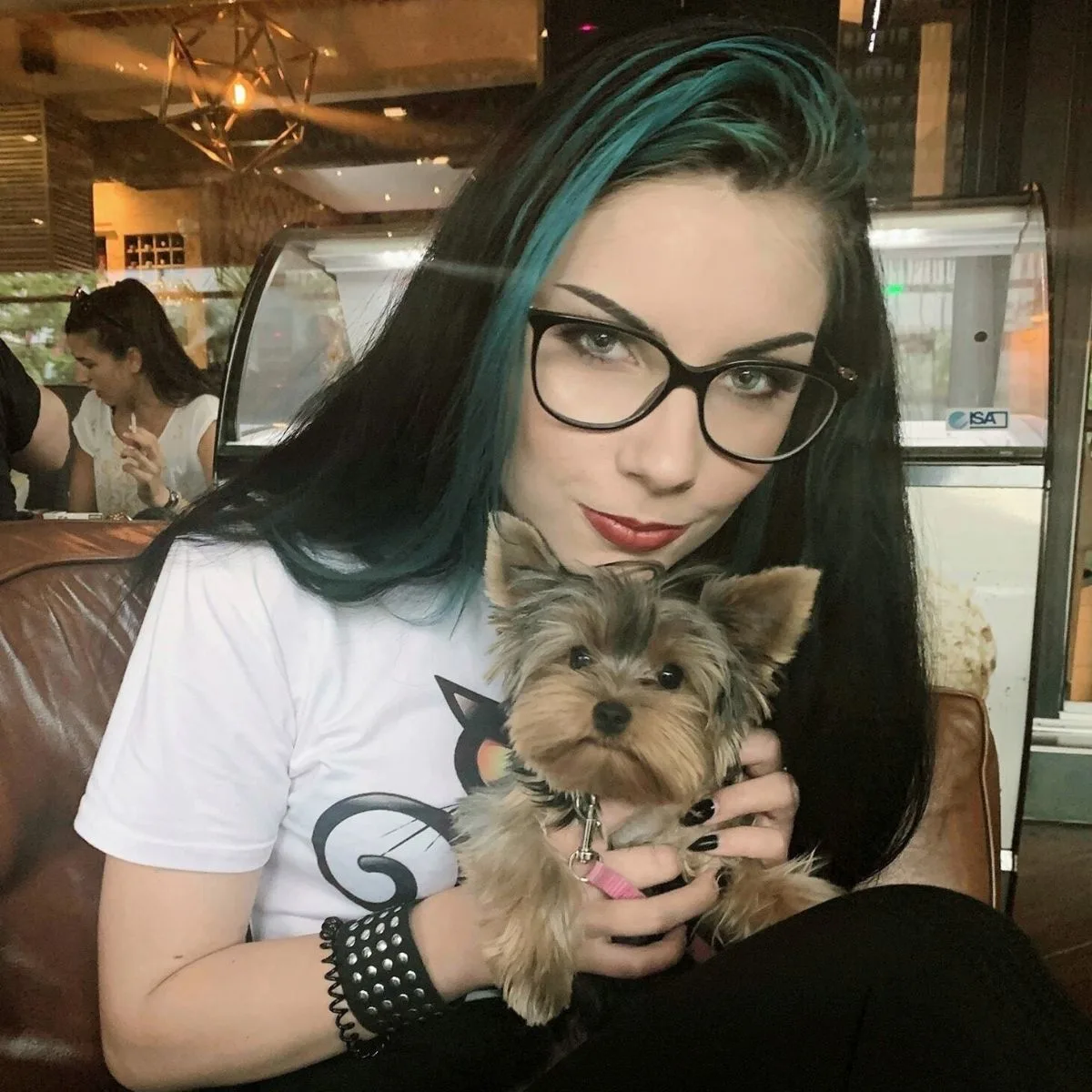
Vanja’s passion for writing started at an early age, which is why she pursued Journalism as her college degree. She can research any topic and find all the information before you bat an eye, which is a great thing for her job but a terrible one for her husband.
Even as a young child, she fell in love with everything fluffy – but dogs have a special place in her heart due to her childhood companion, a Corgie named Archie.
Motivated by her experiences and driven by a desire to give back to her four-legged companions, she spends her free time volunteering at a local dog shelter.
